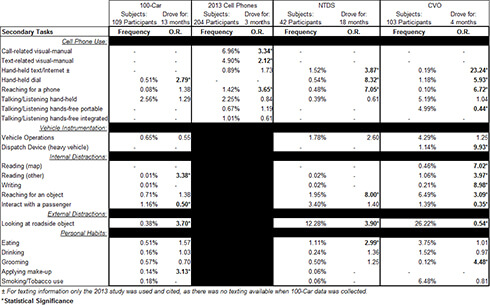
April 1, 2015
No one knows better than the Virginia Tech Transportation Institute the extent of driving distraction as the cause of crashes.
We identified it as the reason for most crashes and documented the leading distractions as: driver inattention, due to fatigue; and texting while driving, particularly by inexperienced drivers.
Frequently Asked Questions
- What is distracted driving?
Driver distraction is the diversion of attention from activities critical for safe driving towards a competing activity. - How often are we distracted while driving?*
When we sample data and filter out all non-driving related activities, we find that drivers are doing nothing but driving only 46 percent of the time. When it comes to cell phone use, we find that drivers use a cell phone 15.7% of the time, text 3% of the time, Dial 0.3% of the time, and Talk on a cell phone 10.8% of the time. - Who drives distracted?*
Everyone. Commuters, professional truck drivers, teens. - What is the worst form of distraction?*
By far the worst form of driver distraction is text messaging. Our research shows that texting can increase your risk by up to 23 times. However, it goes beyond texting. Any activities that take your eyes off the road have been shown to be risky. - What can I do?
- Keep your eyes on the road.
- Pledge not to drive distracted.
- Participate in research.
* – Answers based on VTTI’s study results.
Percentage of increased crash risk associated with distracted driving tasks
Click image for larger version.

Odds ratio analyses were calculate d to identify tasks that were high risk. That is, tasks that were associated with an increased likelihood of involvement in a safety-critical event compared to uneventful baseline driving. Odds of occurrence were defined as the probability of event
occurrence (safety-critical event) divided by the probability of non-occurrence (baseline epoch).
These probability estimates were conditioned on the presence/absence of the behavior of interest and then compared via ratios.
The Experts

Dr. Charlie Klauer is a research scientist and leader of the Training Systems Group in the Division of Vehicle, Driver, & System Safety. In addition, she is an associate professor in the Industrial and Systems Engineering Department at Virginia Tech. Dr. Klauer has been working in transportation research since 1996; prior to joining VTTI in 1999, she worked at the Battelle Human Factors Research Center in Seattle, WA. At VTTI, she has served as the principal investigator (PI) for a series of naturalistic driving studies (NDS) including three teen NDSs and the Canada Naturalistic Driving Study. She currently serves as the PI of the Driver Adaptation of L2 Technologies study and for two additional NDSs that are focused on adolescents. The first of these is concerned with adolescents diagnosed with Autism Spectrum Disorder and the second NDS is focused on adolescents diagnosed with Attention-Deficit/Hyperactivity Disorder.

Dr. Richard Hanowski is a senior research scientist and serves as the director of the Division of Freight, Transit, & Heavy Vehicle Safety at VTTI. Dr. Hanowski has been involved in transportation human factors research since 1991 when he was a graduate student working at the National Center for Advanced Transportation Technology at the University of Idaho. His career has included an internship at General Motors and three years as a research scientist at Battelle in Seattle. His experience includes transportation human factors with both heavy & light vehicles, laboratory & field testing, simulation, advanced system development & testing, naturalistic driving, design guideline development, and human performance evaluation.

As director of VTTI for 25 years, Dr. Thomas Dingus managed more than $800 million in research funding on projects designed to enhance transportation safety, improve the efficiency of our transportation system across multiple users (e.g., teen drivers, older drivers, commercial vehicle drivers, motorcyclists, pedestrians), assess driver performance and behavior, and ensure the safe and efficient development and deployment of advanced vehicles (including automated vehicles).
Riskiest Teen Driving Behavior Videos
VTTI research has determined that the following secondary tasks teen drivers engage in can put them at higher risk for crashes or near crashes: